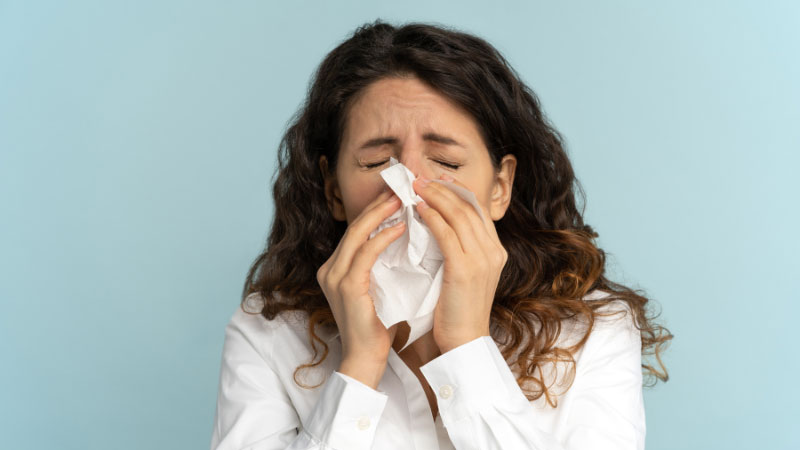
Do you have a condition that makes it harder to breathe sometimes? These simple tweaks around your home may help relieve symptoms.
You might not think much about the air you breathe. That is, unless, you’re one of the millions of Americans living with a condition like asthma or chronic obstructive pulmonary disease (COPD). These conditions affect your lungs and make it harder to breathe. And what’s in the air can make these conditions worse.
Symptoms of asthma and COPD can include coughing, wheezing and shortness of breath. Allergens like pollen and pet dander can make these symptoms worse. So can other triggers, like dust or smoke.1,2
“COPD develops over time from irritants to the lungs like tobacco smoke or other chemicals,” says Sarah Kent, MD from USMD Cross Roads Clinic in Cross Roads, Texas. Asthma can happen to anyone. It often starts in childhood.2
Sometimes people with long-term asthma can develop COPD as well. What you breathe in can trigger a flare-up of symptoms of asthma and COPD. According to Dr. Kent, a flare-up is likely to leave you feeling ill, much like a particularly nasty chest cold.
There’s no cure for asthma or COPD. But there are ways to minimize triggers and prevent flare-ups. Dr. Kent recommends you start with your house. Here are five common asthma and COPD triggers that may be hiding in your home.
 Trigger 1: Smoke
Trigger 1: Smoke
If you have COPD or asthma and smoke or are around smokers, it can worsen your symptoms. “Cigarette smoke is one of the leading causes of COPD and the leading cause of ongoing symptoms,” says Dr. Kent.
Other kinds of smoke, like from a fireplace or stove, can trigger asthma and COPD symptoms, too.3,4
Solution: The best way to keep your symptoms from getting worse is to stay away from smokers. That includes not smoking yourself. Another option? Try encouraging family members who smoke to quit. Or if you’re a smoker, make a plan to quit. Your doctor can help.
When cooking, be sure to use vent fans to clear smoke. Avoid using wood-burning stoves or fireplaces. If you do, make sure they’re well-ventilated.5
Trigger 2: Strong odors
If you like to keep a home that’s clean and smells nice, you might be causing COPD and asthma flare-ups. According to Dr. Kent, odors and scents can be irritants for some people and may cause COPD symptoms to worsen. This is especially true for people whose COPD is caused by asthma or allergies.
Here are products that can worsen symptoms:3,4
- Air fresheners
- Cleaning products
- Paints
- Scented candles
Solution: Avoid scents that worsen your symptoms, advises Dr. Kent. Choose products that are unscented. You can also try using natural, fragrance-free cleaning products. And, open windows and turn on fans while cleaning your home.
Trigger 3: Pet dander (flakes of skin)
Many Americans have pets in their homes. In fact, 3 in 5 households have a pet, according to the American Lung Association (ALA). And flakes of pets’ skin (dander) are a common allergen that can make breathing problems worse.5
If your COPD is related to long-term asthma or allergies, being around pets could be a trigger if this is an allergen, says Dr. Kent.
Solution: The best strategy is to stay away from furry pets that trigger allergies and breathing problems.
If you must be around furry friends, you can help keep dander at bay by brushing your pets regularly and cleaning up their hair and dander with thorough cleaning. Dr. Kent recommends using house and vacuum air filters regularly. Wash your hands, or even take a shower, after contact with animals. Wash your clothes, sheets and anything else that pets touch. Better yet, keep pets out of your bedroom.3,6
Trigger 4: Dust and dust mites
The dust in your home has everything from dead skin cells to dust mite droppings and body fragments in it.7,8 (Dust mites are tiny, insect-like creatures that eat flakes of skin.)
When you breathe in dust, it can cause you to have an allergic reaction. One recent study showed that being around dust can make COPD symptoms worse.9
Solution: “Try to keep your home as clean as possible,” says Dr. Kent. “Vacuum regularly, especially under furniture and in closets. You can also try using a dehumidifier to help reduce the humidity in your home, which can help keep dust mites from thriving.”
Washing linens with hot water will help kill and wash away dust mites.7 ALA recommends dusting with a damp cloth. It will trap dust better, instead of stirring it up into the air.7
The ALA also advises reducing the places where dust might be. You can:8
- Cover mattresses and pillows with anti-allergen covers.
- Remove clutter, such as stuffed animals and piles of clothing.
- Remove upholstered furniture or use furniture with smooth surfaces.
- Remove drapes and curtains.
- Replace carpets.
An air purifier can also help clear dust and other allergens from the air. Look for one with a HEPA (high-efficiency particulate air) filter. These have been shown to reduce airborne allergens like dust and pet dander.10
Trigger 5: Humidity and mold
Humid air can be harder to breathe, and it can lead to mold in your home, which is another common asthma and COPD trigger.11 Dampness and humidity can also attract dust mites, bugs and bacteria.
Solutions: The ALA advises that you keep the humidity levels in your home below 50%.11 Check to see if your home thermostat measures humidity. If not, you can buy an inexpensive hygrometer to measure the humidity in your home. Air conditioners and dehumidifiers can help lower humidity.
Since mold lives in damp places, it is important to get rid of the source. That might include fixing:
- Leaks
- Plumbing issues
- Ventilation problems in rooms, such as bathrooms
You can clean mold off hard surfaces by scrubbing with soap and warm water. Wear a mask and gloves while cleaning mold. If you have mold covering a large area in your home (more than 10 square feet), you may need professional help to clean it.11
Sources
- National Heart, Lung, and Blood Institute. What is COPD? Last updated March 24, 2022. Accessed March 30, 2023.
- National Heart, Lung, and Blood Institute. What is Asthma? Updated March 24, 2022. Accessed April 21, 2023.
- American Lung Association. Prevent COPD exacerbations or flare ups. Last updated March 27, 2023. Accessed March 30, 2023.
- American Lung Association. Reduce Asthma Triggers. Updated March 21, 2023. Accessed April 20, 2023.
- National Heart, Lung, and Blood Institute. Managing asthma. Last updated March 24, 2022. Accessed April 28, 2023.
- American Lung Association. Pet dander. Last updated November 17, 2022. Accessed March 30, 2023.
- American Lung Association. Dust and indoor air quality briefing. Accessed March 31, 2023.
- American Lung Association. Dust mites. Last updated November 30, 2022. Accessed March 31, 2023.
- American Journal of Respiratory and Critical Care Medicine. Home dust allergen exposure is associated with outcomes among sensitized individuals with chronic obstructive pulmonary disease. Published February 15, 2022. Accessed March 31, 2023.
- American College of Allergy, Asthma, and Immunology. Air Filters. Accessed April 20, 2023.
American Lung Association. Mold and dampness. Last updated November 17,
